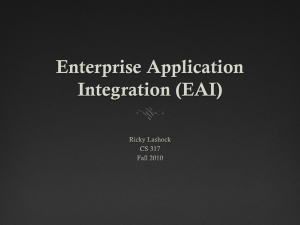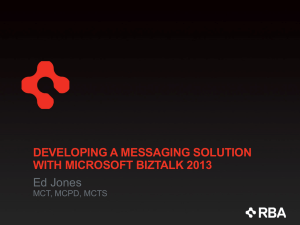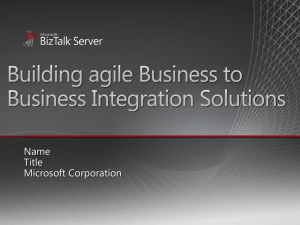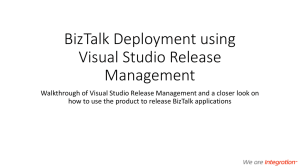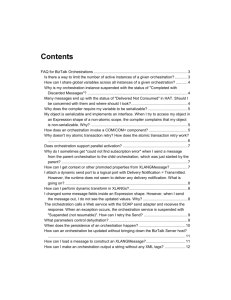1 - Microsoft
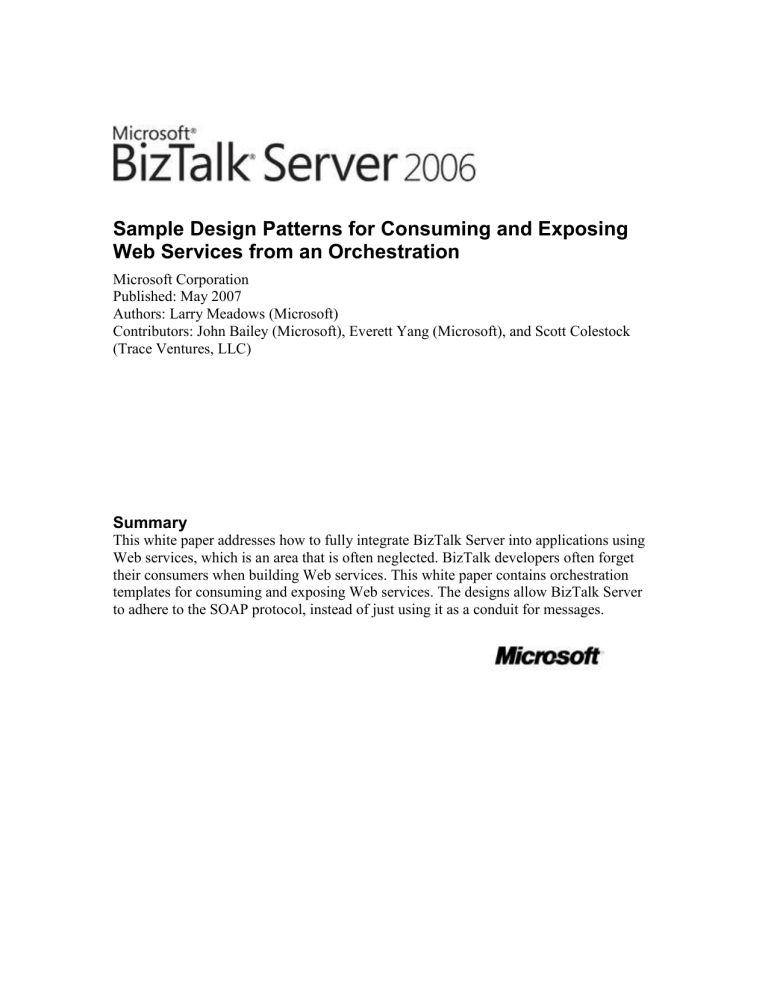
Sample Design Patterns for Consuming and Exposing
Web Services from an Orchestration
Microsoft Corporation
Published: May 2007
Authors: Larry Meadows (Microsoft)
Contributors: John Bailey (Microsoft), Everett Yang (Microsoft), and Scott Colestock
(Trace Ventures, LLC)
Summary
This white paper addresses how to fully integrate BizTalk Server into applications using
Web services, which is an area that is often neglected. BizTalk developers often forget their consumers when building Web services. This white paper contains orchestration templates for consuming and exposing Web services. The designs allow BizTalk Server to adhere to the SOAP protocol, instead of just using it as a conduit for messages.
Contents
ii Consuming and Exposing Web Services from an Orchestration
Introduction
Microsoft® BizTalk® Server makes working with Web services easier. However, one related area often neglected is how to fully integrate BizTalk Server into applications using Web services. This white paper presents orchestration templates for consuming and exposing Web services. The designs allow BizTalk Server to adhere to the SOAP protocol, instead of just using it as a conduit for messages. This keeps the flexibility and compatibility intended by SOAP. It is also important not to forget about the message once it leaves the orchestration. This is an absolute necessity for robust applications.
Developers, more often than not, will invoke a Web method from an orchestration with, at most, a general exception block. If an error occurs, BizTalk Server retries a few times and finally suspends the operation. There is logic behind this approach; most failures are connection-related.
BizTalk Server handles this situation with no further action required.
However, after thousands of calls, even a low percentage of problems a retry cannot fix leads to an unnecessarily difficult recovery. Manual effort is the accepted price to fix possibly hundreds of suspended instances. Using the templates discussed in this white paper can offer additional options.
BizTalk developers often forget their consumers when building Web services. An invoked method becomes an area of uncertainty to consumers. All they know is that a call was made, and it timed out. The common solution is to try again. If the problem is not connection-related, needless network traffic and processing are generated.
Another common approach used when building BizTalk Web services is to bury error information inside an object being returned. This approach can work, but it causes the consumer to handle errors in a nonstandard way; modern programming languages expect exceptions to be raised when problems occur.
The reason these techniques evolved is generally because the alternative is not well documented. The following templates demonstrate how to overcome these weaknesses. The cost is little more than understanding how to properly configure BizTalk Server.
Consuming Web Services
There are three areas to consider in addition to processing, when consuming Web services in
BizTalk Server:
Catching SOAP exceptions
Finding the SOAP exception text
Catching general exceptions
The majority of the work is configuration. Some of the details are not obvious. Here are the steps to create the template.
1. Add a project reference for “System.Web.Services.” This provides access to the SOAP exception type.
2. Set the orchestration transaction type to Long-Running . This provides access to Scope shapes with exception blocks.
3. Add a Scope shape as a container for processing for the orchestration. Set the transaction type to Long-Running .
4. Add two exception-handler blocks to the scope —one for SOAP exceptions and the other for general exceptions.
5. Configure the first exception block to trap
“System.Web.Services.Protocols.SOAPExceptions.” Name the exception something descriptive like “eSOAP.” The actual text returned by the Web services is located in
“eSOAP.Detail.InnerText.” Parse this string, and take action based on the particular error.
Remember that there is an undelivered message. Program the catch block to handle recovery.
Note Dynamic send ports sometimes incorrectly return null in the “InnerText.” Check with Microsoft for hot fixes related to this issue.
6. Configure the second exception block for general exceptions. Examine the
“MyMessage(BTF2.fault_faultstring)” context attribute to determine the action required for recovery. Other useful context attributes, such as fault code, might be useful for determining the problem. Any message used in the orchestration could cause the exception, so check all messages.
7. Configure the send port retries to zero during testing. This allows the exception code to handle the problem. Otherwise, BizTalk Server retries and waits for several minutes by default before failure. This change could also be part of the design, depending on how exceptions are handled. For example, if the design is more likely to fail because of bad data rather than connection problems, it would be better not to retry until the error is examined. Retry might be one of several potential recovery paths.
8. Finally, consider what happens after the message leaves the orchestration. BizTalk
Server 2006 users configure Enable routing for failed messages on the send port. This change causes BizTalk Server to publish a message when an error occurs in the port.
Create a subscription for these messages, and then handle the recovery. This often means creating another orchestration to contact the appropriate party or to reset values updated by previous processing.
Note BizTalk Server 2004 users can subscribe to Negative Acknowledgement (NACK) messages that BizTalk Server publishes when a message is suspended. The process is similar to the behavior in BizTalk Server 2006. Details for NACK orchestration are beyond the scope of this document.
2 Consuming and Exposing Web Services from an Orchestration
Orchestration Template for Consuming Web Services
Exposing Orchestrations as Web Services
BizTalk Web services are often created like any other BizTalk orchestration. Although this works, it does not result in fully developed Web services. Specifically, it does not facilitate fault communication. The caller expects to receive SOAP faults when things go wrong. Instead BizTalk developers create custom error handling. The caller has to be aware of this versus expected Web service fault behavior. BizTalk Server provides the mechanism to return SOAP faults for unexpected and custom errors. This enables the caller to code using standard try/catch block trapping of SOAP exception types.
Users who attempt to build their own designs often find a couple of problems not easily understood, but fortunately are easily solved. Only one response message can be sent to the request/response port. If the user adds a Send shape to return a message and another Send shape for a SOAP fault, the project fails to compile. Also, accessing SOAP fault message configuration in the orchestration is not obvious.
Consuming and Exposing Web Services from an Orchestration 3
Add an orchestration to a project to build the template. Use the BizTalk Orchestrations Toolbox to add the following shapes with the properties described.
1. Add an orchestration, and set the transaction type to Long-Running .
2. Add a Receive shape, and set it to Activate .
3. Create a message (“myFault”) of type String .
4. Add a Scope shape. Set the transaction type to Long-Running .
5. Add an exception block to the scope.
6. Add the processing required inside the scope.
7. Add a second Scope shape of type Atomic .
8. Add a Send shape to pass successful processing back to the client.
9. Place the Send shape inside the Atomic scope.
10. Add a Decide shape inside the exception block.
11. Add a Send shape to the success side of the Decide shape.
To update the orchestration, configure the following:
1. Set Rule_1 of the Decide shape to “!succeeded(Transaction_2)”. This is case-sensitive and “Transaction_2” refers to the “Transaction Identifier” attribute of the Atomic scope.
2. Configure the decision true condition with a Send shape to send the “myFault” message.
3. Examine the error provided to the catch block. The error will be stored in the context of the message sent from the Atomic scope. Check the “BTF2.fault_faultstring” context attribute. Populate “myFault” with the error or add custom text for return to the caller. This takes care of the compiler issue.
4. From the BizTalk Orchestrations Toolbox, add a public request/response port to expose the Web service.
5. From Orchestration View, expand Port Types . Select the port type just created, rightclick the type, and select New Fault Message to add a connection for a SOAP fault. This takes care of access to the fault message configuration.
To handle user-defined SOAP faults, configure the following:
1. Populate the “myFault” message with the desired error text (pre-populating error string variables helps organize if several custom responses are required).
2. Add a Send shape for the fault message, and connect it to the fault message on the port.
3. Complete this processing path with a Termination shape from the toolbox.
4. Repeat this sequence when custom errors are required.
To handle fatal unexpected errors, configure the following:
1. Unexpected errors thrown outside the Atomic scope are caught in the general exception block. Insert these into the event log for analysis. Such problems usually mean the orchestration is unable to function.
2. Take care to design an appropriate recovery path, and alert the appropriate staff when addressing these failures.
3. Deploy the orchestration with the Web Service Deployment wizard.
4. Remember to handle problems after the message leaves the orchestration.
4 Consuming and Exposing Web Services from an Orchestration
To handle port failures, configure the following:
1. Select the send port, and turn on Enable routing for failed messages .
2. Subscribe to the failed messages, and take appropriate action. This is usually another orchestration used to examine the problem.
3. Inform either IT or business staff, based on the failure.
4. When designing the response message, include information to facilitate recovery (such as customer ID, e-mail address, and other information).
Note BizTalk Server 2004 users can subscribe to Negative Acknowledgement (NACK) messages that BizTalk Server publishes when a message is suspended. The process is similar to the behavior in BizTalk Server 2006. Details for NACK orchestration are beyond the scope of this document.
Orchestration Template for Exposing Web Services
Consuming and Exposing Web Services from an Orchestration 5
Conclusion
Working with Web services in BizTalk Server has never been difficult. Follow these templates to take advantage of BizTalk’s built-in SOAP features with very little additional effort. Taking the time to apply these techniques might just make the difference when processing does not go as expected.
6 Consuming and Exposing Web Services from an Orchestration
Copyright
The information contained in this document represents the current view of Microsoft Corporation on the issues discussed as of the date of publication. Because Microsoft must respond to changing market conditions, it should not be interpreted to be a commitment on the part of
Microsoft, and Microsoft cannot guarantee the accuracy of any information presented after the date of publication.
This White Paper is for informational purposes only. MICROSOFT MAKES NO WARRANTIES,
EXPRESS, IMPLIED OR STATUTORY, AS TO THE INFORMATION IN THIS DOCUMENT.
Complying with all applicable copyright laws is the responsibility of the user. Without limiting the rights under copyright, no part of this document may be reproduced, stored in or introduced into a retrieval system, or transmitted in any form or by any means (electronic, mechanical, photocopying, recording, or otherwise), or for any purpose, without the express written permission of Microsoft Corporation.
Microsoft may have patents, patent applications, trademarks, copyrights, or other intellectual property rights covering subject matter in this document. Except as expressly provided in any written license agreement from Microsoft, the furnishing of this document does not give you any license to these patents, trademarks, copyrights, or other intellectual property.
Unless otherwise noted, the companies, organizations, products, domain names, e-mail addresses, logos, people, places, and events depicted in examples herein are fictitious. No association with any real company, organization, product, domain name, e-mail address, logo, person, place, or event is intended or should be inferred.
© 2007 Microsoft Corporation. All rights reserved.
Microsoft and BizTalk are trademarks of the Microsoft group of companies.
All other trademarks are property of their respective owners.
Consuming and Exposing Web Services from an Orchestration 7

